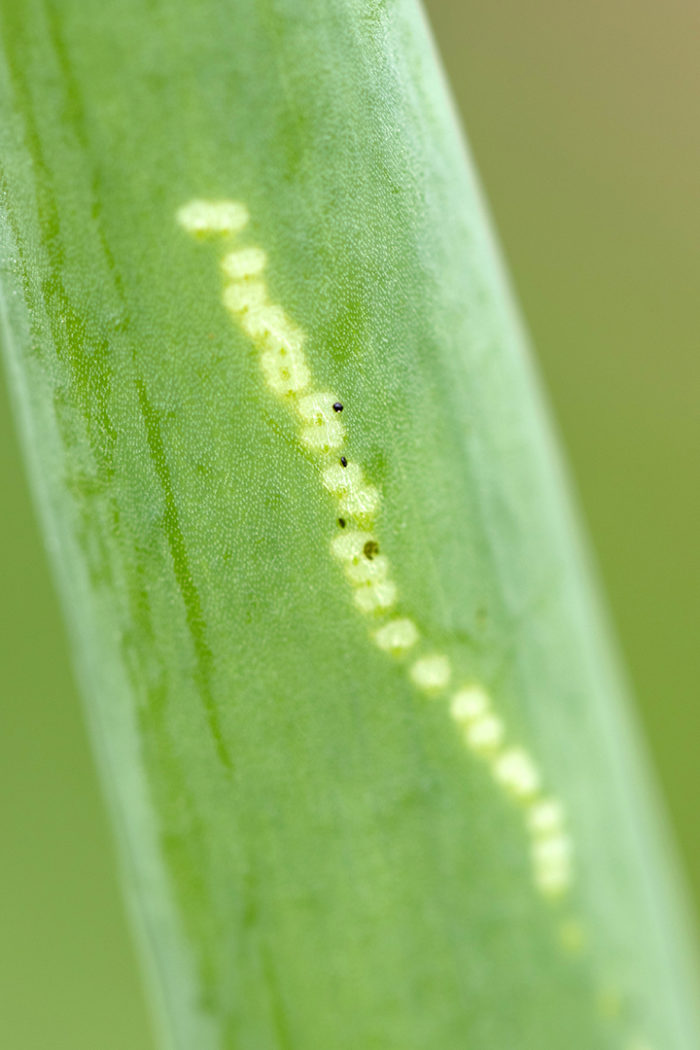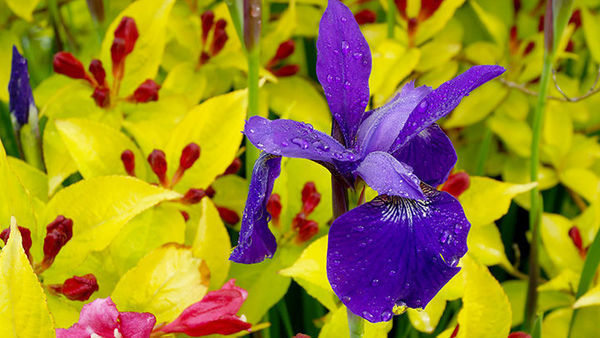
Spotted lanternfly (Lycorma delicatula) is getting a lot of attention as the latest big pest threat in the Mid-Atlantic, but it’s not the only new and serious problem to pop up in our area recently. Allium leafminer (Phytomyza gymnostoma, or Napomyza gymnostoma), also known as onion leafminer, is another invasive insect to watch out for in your garden. Native to parts of Europe, it was first spotted in this country in Lancaster County, Pennsylvania, in late 2015, and as of this spring, allium leafminer has been identified in New York, New Jersey, Massachusetts, and Maryland as well.
As indicated by the name, this pest affects pretty much any species of allium. Besides edibles like onions, leeks, garlic, chives, and shallots, it can also damage ornamental alliums. I first noticed its presence in my Bucks County, Pennsylvania, garden last summer, and the adults appeared again this year the last week of April, causing feeding damage on my regular onions (Allium cepa, Zones 5–10), Egyptian or top-setting onions (A. × proliferum, Zones 3–10), hardneck garlic (A. sativum ssp. ophioscorodon, Zones 4–9), and ‘Forelock’ ornamental onion (A. ‘Forelock’, Zones 4–8).
The adult flies are very small—larger than a fruit fly but smaller than a housefly—so you may not even notice the insects themselves, but their distinctive feeding and egg-laying damage is easy to spot. The females use their ovipositor to punch holes in the leaves, and they and the males feed on the exudate. This activity appears on the upper parts of the leaves as a line of small, pale dots; that’s mostly cosmetic damage, though. The females also lay eggs just under the surface on the lower parts of the foliage. The eggs then hatch, and the larvae tunnel downward, feeding as they go. Their feeding can cause leaf distortion and also makes the plants more susceptible to bacterial and fungal diseases, potentially to the point of making the entire crop unusable.

The allium leafminer is so new here that researchers are scrambling to investigate the best routes for controlling it. Right now, there aren’t many options, particularly for home gardeners. If you’re growing only single-season allium crops, like onions, it may be enough to plant a couple of weeks later than usual to miss the first generation of adults. If you’re growing edible alliums that will have foliage in late summer or early fall (when the second generation of adults emerges) and/or in spring—leeks, garlic, and chives, for example—using row cover can prevent the adult flies from feeding and laying eggs on the leaves. That won’t help on ornamental kinds, though. There’s not much point in growing the big, gorgeous globes of ‘Gladiator’ flowering onion (Allium ‘Gladiator’, Zones 4–7) and other show-stoppers if you have to cover them up!
If you grow any kinds of alliums in your garden, keep your eye out for more information on the status of this pest as it moves throughout the Mid-Atlantic region. Consider checking the website for your state’s cooperative extension service every few months to keep up with the latest news on this pest in your particular area.
Nancy J. Ondra is the author of over fifteen books, including Grasses, The Perennial Care Manual, and The Perennial Matchmaker.


















Comments
Log in or create an account to post a comment.
Sign up Log in